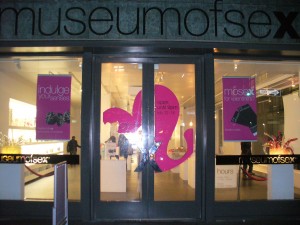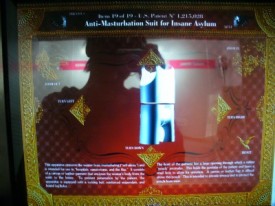Museum of Sex, NYC
The museum managed to create a traceable history of our modern attitudes towards sex. I especially liked how all of the exhibits (and items in the gift shop) were presented in an open and informative manner.
The bunny bondage hood was wonderfully creative. Bondage apparel is usually depicted as dark, tight and uncomfortable. The bunny hood puts some fun and humor in a subculture of pleasure and pain that one would not normally associate with playfulness. Moreover, for $300, that piece had better be considered art. I cannot imagine anyone purchasing it for casual use.
The condom exhibit was definitely a revelation. I have always been curious about preventative sexual practices before the 20th century. I was familiar with lambskin condoms from my readings but I had never seen one before. You can imagine my amazement when I saw the various incarnations of condoms from the past two centuries. The gourd condom was a bit disturbing. It could just have been art, but I have my doubts.
A perfect example of how the museum connected daily practices with past and present historical events was the Syphilis exhibit. It followed the condom exhibit and preceded the heartbreaking story of the Tuskegee study. There are so many references to the disease in literature, and yet it is not something that we (thankfully) have to worry much about today. Syphilis was the bogeyman of sexually transmitted diseases before the outbreak of AIDS. Amazingly, the disease that afflicted and killed millions (perhaps billions over time), is now treated with penicillin – an antibiotic whose availability we take for granted today. An interesting interpretation of Charlotte Bronte’s Jane Eyre was that the Mr. Rochester’s first wife, Bertha, was in the late stages of syphilis infection, and that was why she was crazy and ill.
I was a bit startled by the anime display. It was female brutalization in a hyper-realistic form. There could be no question about its message. Even the scenes that featured strong, competent heroines had the females viciously (and graphically) attack, raped, and discarded. There was definitely a power struggle in these films, and the female always lost. It just reminded me of an article that I read recently that spoke out against violence against women.
*Just a side note: when considering sciencia sexualis, one should think not only of all of the experiments done in the name of understanding human sexuality, but also the subjects who had to submit to those experiments. Minorities across the board have been used as guinea pigs simply because of their race, gender, and psychology. From the dreadful experiments committed against innocent African American men (and their families) during the Tuskegee Experiments, to the absolutely irrational anti-masturbatory metal suits that mental patients were forced to wear at the turn of the century, the ignorance and arrogance of early 20th century “doctors” has hurt more than assisted.
On the next floor, there were displays of sexuality that are less popular with the mainstream – sex dolls, sex machines, and videos with disturbing footage of more extreme sexual practices. But amongst those displays were some moving pieces, particularly the display about a transgender woman’s journey through gender reassignment, and art by Keith Haring, who fought for AIDS awareness, safer sex practices, and gay rights.
Lastly were the sex films. I had no idea that there were so many eras of porn. I was familiar with the vintage stag films, and of course, the golden age films from the 1970s’s. However I had never considered Pam Grier as a sexploitation actress (though, in hindsight, I can see how many blaxploitation films could be considered as such). Ditto with Tarzan. I loved how the exhibit put these films into their rightful place on the timeline of cultural and historic relevance.
Overall, this was a great trip. It is very rare to have several strangers in the presence of straightforward sexuality, trying their best to put aside their reservations, prejudices, and hang-ups in order to simply understand what it means to be a sexual being. The Museum of Sex is not salacious. It is essential. It presents artifacts from human sexual history that have simultaneously been suppressed and exploited. The museum exists to turn on our biggest sex organ – our brains. And it succeeds.
Tags: art, condoms, education, gender, identity, museum, porn, race, scientia sexualis, syphilis, violence












February 18th, 2010 at 2:21 pm
Hi Sharon, this photo essay of your visit is not only engaging, it is also well-attuned to historical moments. I’d like you to add some comments that bring in the debate or main ideas put forward by Weeks and Norton (remember that the posts are intended to make links between readings and here I consider the texts in the Museum as readings). I think one place you might do this is in your insightful comments about scientia sexualis in light of the Tuskegee Experiments. This is far more important than a “side note”–it’s a key point–and you have effectively underscored the Museum’s emphasis on education. Please read my comment to David on Weeks and Norton as well.